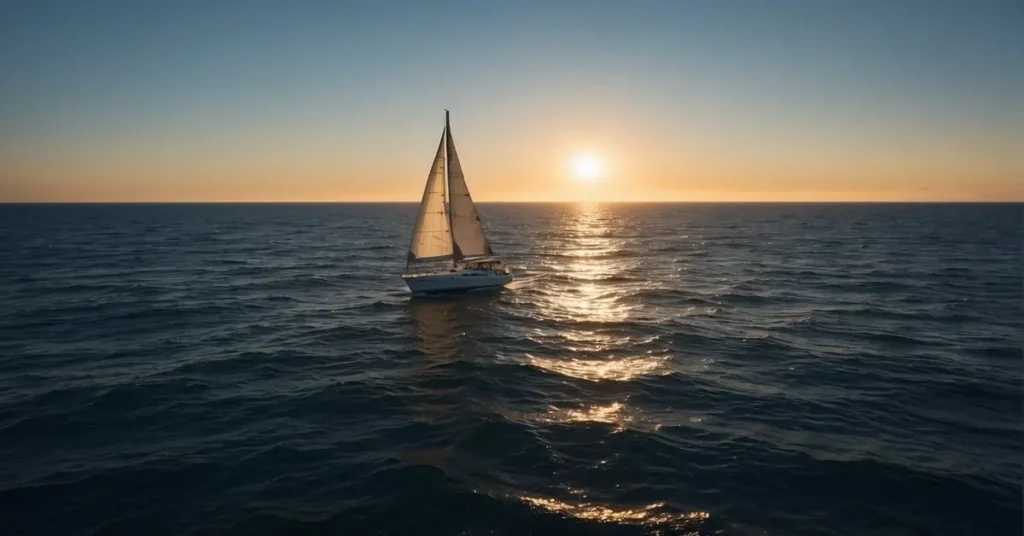The quest for the title of the world’s fastest sailing boat is a thrilling adventure that captures our collective imagination. It’s a dynamic challenge where engineering prowess, sailor skill, and Mother Nature’s moods collide, pushing the boundaries of what we once thought impossible. With every new design and technological advancement, sailboats are slicing through the water at unprecedented speeds, turning the open ocean into a high-velocity playground.
The synergy of wind and wave spellbinds us, and nothing exemplifies this more than the vessels streaking across the sea’s surface, setting awe-inspiring records. These feats are not just for the record books; they represent the pinnacle of maritime achievement. From the 65.45 knot barrier that once seemed untouchable to the recent attempts to shatter it, every knot increase in speed marks a significant milestone in sailing history.
Exploring this nautical niche takes us on a global journey, showcasing how international competition and collaboration propel the sport forward. As we follow the leads of pioneers who endeavor to craft the fastest sailboat, we share the excitement of each nautical leap. These record-setting endeavors are not just a race against time; they reveal our passion for innovation and the relentless human spirit propelling us across the water faster than ever before.
History of Speed Sailing Records
The quest for speed on the water has crafted a rich tapestry of competition and innovation within nautical endeavors. We’ve witnessed sailors push the boundaries of physics and emerge victorious with new records, fearless in their pursuit of unparalleled velocity.
Milestone Achievements
The world of speed sailing brims with exhilarating moments, but none as groundbreaking as when Paul Larsen steered the Vestas Sailrocket 2 to glory. In 2012, he shattered the sailing speed record, hurtling through the water at an astonishing 65.45 knots. This feat solidified his historical place and set a new benchmark for sailors worldwide.
- Notable Records: Pascal Maka – First official windsurfer world record.
- Simon McKeon – Recorded a historic run with Macquarie Innovation.
- Alain Thébault – His creation, l’Hydroptère, flew above waves with its innovative design.
Influential Sailors and Innovators
The bravery of sailors like Sébastien Cattelan and Alex Caizergues has been pivotal, with Caizergues earning his stripes by setting multiple kitesurfing records. Innovators don’t fall short, as minds such as Bernard Smith, with his groundbreaking A Class catamaran concept, have revolutionized what we thought possible.
- Revolutionary Innovators: Bernard Smith is the visionary behind the innovative ‘Aerofoil’ design.
- Alain Thébault – Creator of the hydrofoil marvel, l’Hydroptère.
Advancements in Boat Design

In our quest for speed on the water, we’ve witnessed a surge of innovations, blending engineering prowess with the undying human spirit. Let’s explore these daring designs that chart new courses in sailing history.
Sailrocket’s Revolutionary Build
Sailrocket became a beacon of inspiration with its multiple nautical mile records, changing the game for speed enthusiasts. It’s not just a boat; it’s a crossbow on water, a marvel that challenged traditional designs thanks to its unique force alignment and aerodynamics. We saw the application of carbon fiber and Kevlar as complementary and fundamental to achieving new feats in the sailing world.
Cutting-Edge Hydrofoil Technology
Hydrofoil technology has lifted boats like l’Hydroptère and catamarans from the drag of the waves, allowing them to “fly.” The SP80, with its mission to shatter speed records, incorporated hydrofoils to reduce resistance and increase velocity. This technique is also seen in multihulls and trimarans, turning previously calm cockpits into adrenaline-pumping command centers.
Materials that Push the Limits
Our pursuit of the fastest sailboat has led us to materials once reserved for aerospace. Carbon fiber gives us the strength and flexibility demanded by the rigorous seas, while Kevlar provides resistance to abrasion and tearing. As a result, today’s fastest yachts aren’t just formidable in speed; they embody robustness that can withstand the forces they encounter.
These advanced materials allow sails, kites, and foils to thrive under extreme conditions while pushing the boundaries of what a sailboat can achieve. For more information regarding speed and design, you can find our article about how fast a sailboat goes here.
Breaking Records and the Future of Speed Sailing

Speed sailing has continuously pushed the boundaries of maritime achievement. Today, we’re on the cusp of witnessing sailboats break the 80-knot barrier, an endeavor that challenges both technology and human ingenuity.
The Quest for 80 Knots
We’re witnessing a groundbreaking phase in speed sailing, where the fastest sailboat title is ever more contested. Teams worldwide are channeling efforts to shatter the world sailing speed record, with the current pinnacle at 65.45 knots.
One challenger, the SP80, pairs sleek design and cutting-edge technology, aiming to break the current record and surpass 80 knots, a milestone that once seemed unattainable. At these speeds, phenomena such as cavitation come into play, where air bubbles potentially damage propeller blades, a challenge engineers are determined to overcome through rigorous testing.
Venues for Velocity
Regarding setting world records, location matters; the French Trench, also known as the Saintes Maries de la Mer speed canal, and Luderitz, Namibia, are among the chosen battlegrounds for records due to their ideal wind conditions. Here, teams like the Sailrocket have become legends as they harness the relentless winds to prop their vessels into the record books.
Walvis Bay, Namibia, stands out as a beacon for speed sailing records, recognized by the World Sailing Speed Record Council for its flat waters and consistently strong winds. It is perfect for the sailing elite to test their mettle and potentially make history.
Our Opinion on the World’s Fastest Sailing Boat
The recent launch of the World’s Fastest Sailing Boat represents a significant advancement in sailing technology. By leveraging hydrofoiling and aerodynamic design, this groundbreaking vessel achieved speeds over 80 knots, shattering previous wind-powered records.
In our opinion, developing the World’s Fastest Sailing Boat pushes the boundaries of what’s possible under sail and opens the door to a new era of high-performance boats. Its success demonstrates the incredible innovation happening in the sailing world.
FAQ – World’s Fastest Sailing Boat

The World’s Fastest Sailing Boat holds the record for the fastest speed achieved by a wind-powered vessel. Reaching speeds over 80 knots, this innovative sailboat combines hydrofoiling technology with a highly aerodynamic design to slash through water. Below, you find some more answers to the faqs.
What makes sail boats faster?
Sail shape, hull design, and weight reduction make the World’s Fastest Sailing Boats faster by reducing drag and increasing speed.
What is the fastest a sailboat can go?
The theoretical maximum speed for the World’s Fastest Sailing Boat is 2-3 times wind speed through apparent wind dynamics.
What makes a sailing ship fast?
Efficient sails, hydrofoils, and lightweight hulls make the World’s Fastest Sailing Ship fast by reducing drag.
What is the name of a fast sailing boat?
Examples of the World’s Fastest Sailing Boats are the Vestas Sailrocket 2, which reached 65 knots.
The accomplishments of the world’s fastest sailing boat have pushed the boundaries of what’s possible under sail – Share Your Opinion on the world’s fastest sailing boat in the comments below now!



